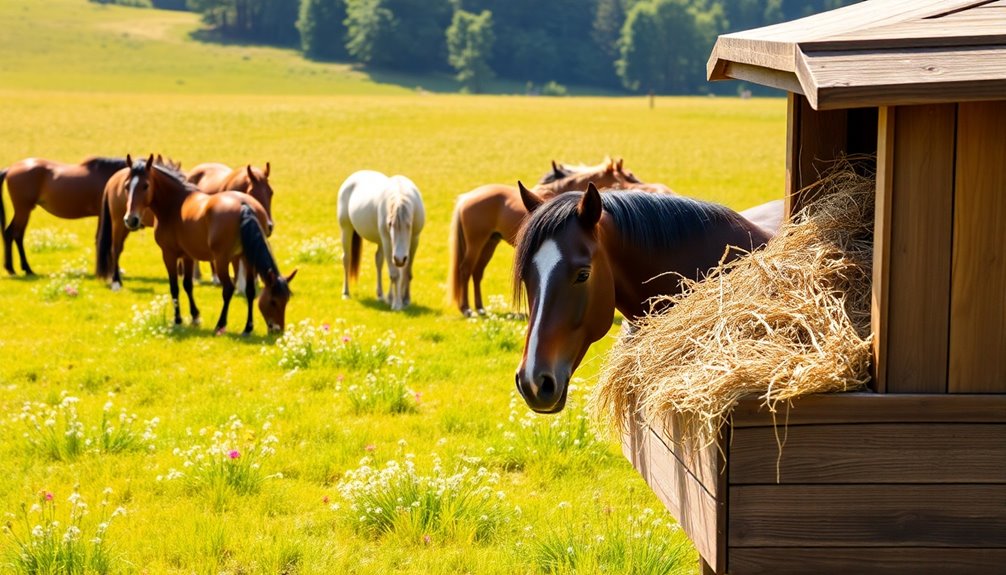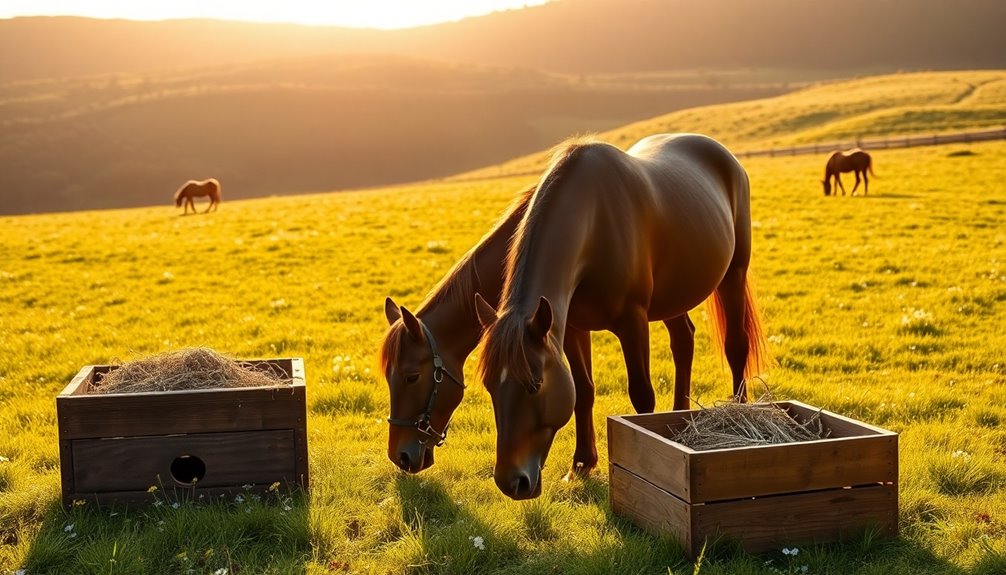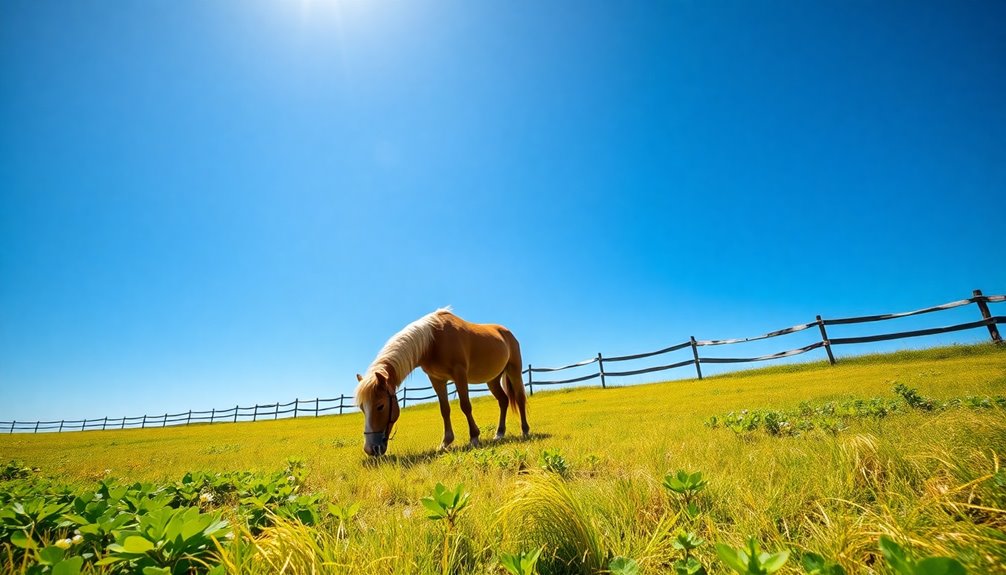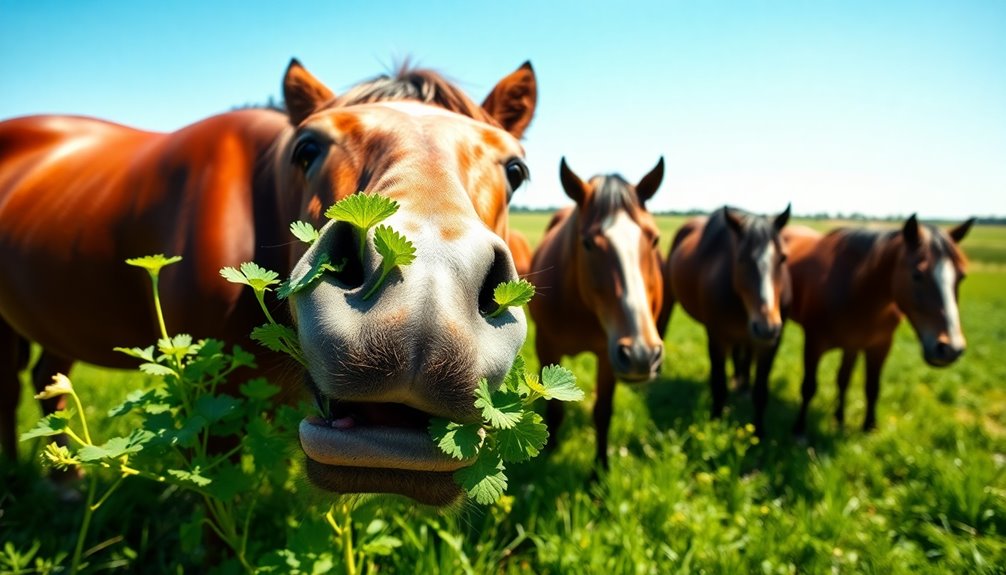Horses need about 1.5 to 2% of their body weight in forage daily to stay happy and healthy. For a 1,000-pound horse, that's roughly 15 to 20 pounds each day. It's important to guarantee forage makes up 70-80% of their diet and to provide continuous access for ideal digestive health. Keep in mind that active horses might require more, while idle ones need less. Regularly monitoring your horse's weight is essential to adjust their intake as needed. Curious about how different forages can affect your horse's health? There's more to explore on guaranteeing their well-being!
Key Takeaways
- Horses require 1.5 to 2% of their body weight in forage daily, approximately 15-20 lbs for a 1,000 lbs horse.
- Forage should make up 70-80% of a horse's diet and should be available continuously to support digestive health.
- Gradually introduce new forage types over 7-10 days to prevent digestive disruptions and maintain health stability.
- Active horses may need up to 20 lbs of forage daily, while idle horses typically require 10-12 lbs.
- Regular weight monitoring is essential to adjust forage intake based on the horse's activity level and overall health.
Understanding Forage Requirements

Understanding your horse's forage requirements is essential for their overall health. Horses need a daily forage intake of 1.5 to 2% of their body weight, which means a 1,000-pound horse should consume about 15 to 20 pounds of forage daily.
Forage is critical, as it should make up 70-80% of your horse's diet, primarily from high-quality hay or pasture. This balanced nutrition supports their energy needs and promotes peak digestive health.
Horses are natural trickle feeders, so they thrive on having continuous access to forage. This approach helps maintain normal digestive functions and prevents issues related to excessive gastric acid exposure.
When introducing new forages, do it gradually over 7-10 days to avoid digestive disruptions and colic. By keeping a consistent supply of forage, you guarantee your horse gets the nutrients they need while also preventing health problems linked to sudden dietary changes.
Types of Forage for Horses

When it comes to feeding your horse, the type of forage you choose plays a significant role in their health and performance. Forage is primarily categorized into two types: fresh forage, like grass pasture, and dried forage, such as hay. Meeting your horse's needs with the right forage is crucial for a balanced diet.
Grass hays, including timothy and orchard grass, are lower in protein and energy. They're ideal for idle or lightly working horses, helping maintain a healthy and happy lifestyle.
On the other hand, legume hays, such as alfalfa and clover, pack more protein and energy. However, be cautious, as these can lead to digestive system issues if your horse doesn't drink enough water.
Always aim for quality forage—look for hay that's bright, clean, and free from contaminants. Regular testing can help guarantee the nutritional value of the forage you provide.
Daily Forage Intake Guidelines

When it comes to your horse's daily forage intake, aim for about 1.5 to 2.0% of their body weight, which means around 15 to 20 pounds for a 1,000-pound horse.
It's essential to provide high-quality forage consistently and make any changes gradually over 7 to 10 days to prevent digestive issues.
Recommended Intake Percentage
Consuming the right amount of forage is essential for your horse's health, as it should account for 1.5% to 2% of their body weight daily. For a typical 1,000-pound horse, this equates to approximately 15 to 20 pounds of forage each day. Meeting this daily intake guarantees proper digestion and helps prevent issues like colic and gastric ulcers.
Here are some key points to take into account:
- Forage Composition: Forage should make up 70-80% of your horse's total diet, providing essential fiber and nutrients.
- Continuous Access: Horses are natural trickle feeders, so providing continuous access to forage helps maintain their digestive balance and reduces gastric acid exposure.
- Daily Monitoring: Regularly monitor your horse's weight and adjust their forage intake accordingly to maintain a healthy body weight.
- Digestive Health: Adequate forage helps keep your horse's digestive system functioning properly, preventing disruptions.
Importance of Gradual Changes
Adjusting your horse's forage intake requires careful consideration, as sudden changes can lead to significant digestive issues. Horses have sensitive digestive systems that thrive on consistency.
To minimize the risk of colic and other digestive disturbances, you should implement gradual changes over a period of 7 to 10 days. This means slowly introducing new forage types or adjusting the quantity to guarantee your horse adapts comfortably.
It's essential to provide continuous access to forage, as horses are natural trickle feeders. They benefit from small, frequent meals throughout the day, which helps maintain their digestive health.
Regular monitoring of both the quality and quantity of forage is vital to meet your horse's nutritional needs effectively. Aim for a daily forage intake of 1.5% to 2% of your horse's body weight—about 15 to 20 pounds for a 1,000-pound horse.
Effects of Forage on Health

For horses, the right amount of forage is essential for maintaining health and well-being. Adequate forage intake plays an important role in supporting their digestive systems and preventing health issues.
- Digestive Health: Forage promotes saliva production, which aids digestion and reduces the risk of gastric ulcers when horses have continuous access to food.
- Nutritional Quality: High-quality forage, like grass or mixed hay, helps prevent nutritional deficiencies, ensuring your horse gets the vitamins and minerals they need.
- Body Condition: The quality of forage directly influences your horse's body condition. Nutrient-rich forage supports ideal weight management and energy levels, vital for performance.
- Behavioral Balance: Insufficient forage can lead to behavioral issues and increased stress. Without enough forage, horses may face health problems such as colic or laminitis due to diet changes.
Adjusting Forage Based on Activity

When it comes to meeting your horse's forage needs, understanding their activity level is vital. Horses should eat 1.5 to 2% of their body weight in forage daily, adjusting this amount based on how active they are.
For instance, if your horse weighs 1,000 lbs and is active, they might need around 20 lbs of high-quality forage to support their energy requirements during training or competition. Conversely, idle horses can thrive on just 10 to 12 lbs of forage a day.
Young horses in growth stages might require up to 15 hours of grazing to meet their increased nutritional demands. It's important to monitor your horse's body condition regularly, especially for those engaged in heavy work. By keeping an eye on their weight, you can adjust forage intake to prevent weight loss or excessive weight gain.
When changing forages, do so gradually over 7 to 10 days to avoid digestive upset. This approach guarantees your horse adapts well to the new forage while meeting their specific activity level needs and maintaining peak health.
Pasture Management Practices

Understanding how to manage your pasture effectively is just as important as adjusting forage based on your horse's activity level. Good pasture management practices guarantee your horses get the right nutrition while keeping the land healthy.
Here are some key practices to follow:
- Rotational Grazing: Move your horses between different pastures to prevent overgrazing. This method allows grass time to regrow and maintain its health.
- Stocking Density: Aim for a stocking density of 2-3 horses per acre. This balance optimizes grazing availability and reduces competition for resources.
- Monitoring Pasture: Regularly check pasture conditions. Seasonal changes can greatly affect the nutritional quality and availability of forage, so staying aware is essential.
- Controlled Grazing: Implement grazing times of 6-10 hours for adult horses. This helps maintain a healthy weight and prevents the obesity that can come from overgrazing.
Additionally, when shifting horses between different types of pasture or feeds, do it gradually over 7-10 days. This minimizes the risk of digestive issues and guarantees their forage needs are met safely.
Importance of Quality Forage

When it comes to your horse's health, the nutritional value of forage is essential.
High-quality forage supports digestive health and helps prevent issues like gastric ulcers.
Regularly evaluating your forage's quality guarantees it meets your horse's needs and promotes peak performance.
Nutritional Value Matters
Quality forage is the cornerstone of equine nutrition, greatly impacting your horse's health and performance. As a horse owner, you must prioritize high-quality hay, like grass and legume varieties, to meet your horse's nutritional needs.
Poor forage choices can lead to nutritional deficiencies that affect your horse's well-being.
Here are four reasons why the nutritional value of forage matters:
- Essential Nutrients: High-quality hay provides important vitamins, minerals, and fatty acids necessary for overall health.
- Protein and Energy: Legume hay, such as alfalfa, offers higher protein and energy content, supporting active horses.
- Daily Forage Intake: Horses should consume 1.5 to 2% of their body weight daily in forage, ideally 15 to 20 lbs for a 1,000-pound horse.
- Preventing Issues: Consistent access to quality forage helps prevent digestive problems like gastric ulcers, as horses are natural trickle feeders.
Digestive Health Support
The nutritional value of forage directly influences your horse's digestive health. To guarantee peak health, aim for a daily intake of 1.5-2.0% of your horse's body weight in quality forage, which translates to about 15-20 lbs for a 1,000 lb horse.
By providing continuous access to high-quality hay, you help maintain a stable pH in the stomach, reducing the risk of gastric ulcers caused by excess acid exposure.
Quality matters when it comes to forage. Always choose hay that's bright, clean, and free from contaminants. Poor-quality forage can lead to digestive issues and nutritional deficiencies, negatively impacting your horse's overall health.
Remember that fiber is essential for proper gut motility and fermentation, which occurs in the cecum. Beneficial microorganisms convert this fiber into volatile fatty acids for energy, imperative for your horse's well-being.
When introducing new forage types, do so gradually over 7-10 days. This gradual shift helps prevent digestive upset, allowing your horse's digestive system to adapt effectively.
Prioritizing the right amount and quality of forage is key to supporting your horse's digestive health and overall well-being.
Forage Quality Assessment
Evaluating forage quality is vital for guaranteeing your horse's health and performance. High-quality forage directly impacts nutritional value, aiding digestion and preventing deficiencies. To assess its quality, consider these key factors:
- Appearance: High-quality forage should be bright, clean, and fresh, free of mold and contaminants.
- Age of Plants: Younger, fresher growth offers better digestibility compared to mature plants, enhancing nutrient absorption.
- Hay Type: Mixing hays is often safer for balanced nutrition. For instance, straight alfalfa hay can create a calcium-phosphorus imbalance, reaching a ratio of 5-6:1.
- Regular Testing: Regularly testing hay allows you to assess its quality and nutrient content, creating a tailored diet for your horses.
Feeding your horse the right amount of high-quality forage each day is vital. Not only does it support their overall health, but it also guarantees that they receive balanced nutrition.
Frequently Asked Questions
How Much Forage Should a Horse Have per Day?
When it comes to daily forage intake for your horse, you should aim for around 1.5 to 2% of their body weight.
For a 1,000-pound horse, that's about 15 to 20 pounds of high-quality forage. Continuous access to this amount is vital for their digestive health, helping prevent issues like colic.
Make sure you shift any new forage gradually over 7 to 10 days to keep their digestive system happy and stable.
How Much Land Does a Horse Need to Be Happy?
You might think one horse can thrive on a tiny patch of grass, but that's far from the truth!
Ideally, you'll want to provide about 1 to 2 acres per horse to keep them happy and healthy.
Stocking density matters too; one horse per acre is best for ideal grazing.
Don't forget to monitor the pasture's condition regularly, ensuring your equine friend gets the nutritious forage they need to flourish!
What Is the Ratio of Concentrate to Forage in Horses?
The ideal ratio of concentrate to forage for your horse is about 1:7. This means for every pound of concentrate, your horse should get seven pounds of forage.
Since forage should make up 70-80% of their diet, it's essential to maintain this balance to keep their digestive system healthy.
If you overfeed concentrates, you risk digestive issues like colic or laminitis, so prioritize that forage for their overall well-being.
What Determines How Much Pasture Is Needed per Horse?
Think of a pasture as a buffet for your horse; its size and quality dictate how satisfying the meal will be.
Each horse needs about 1 to 2 acres to thrive, minimizing competition for resources. Lower stocking densities enhance pasture health, while the types of plants influence the nutritional content.
Seasonal changes also play a role, so you'll have to adjust grazing time and availability to guarantee your horse gets their fill.
Conclusion
In balancing the quantity and quality of forage, you're not just feeding your horse; you're nurturing their happiness and health. While a generous supply keeps them content, the right type guarantees they thrive. Remember, as activity levels rise, so should their forage intake, reflecting their needs. By prioritizing quality and adjusting accordingly, you create a harmonious relationship between your horse's well-being and their environment, proving that sometimes, less truly is more when it comes to health.










